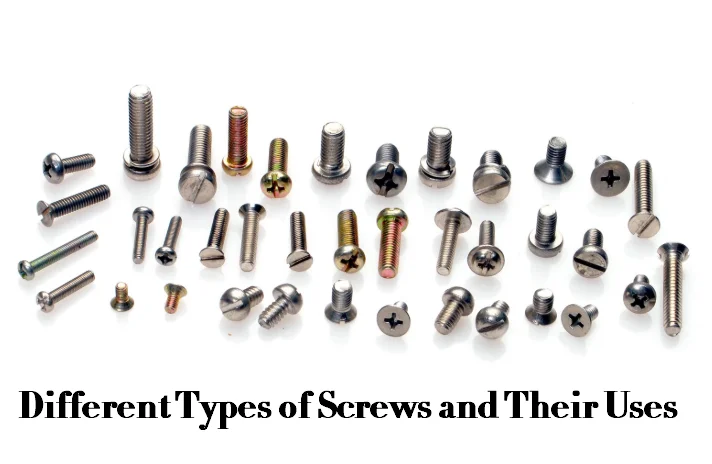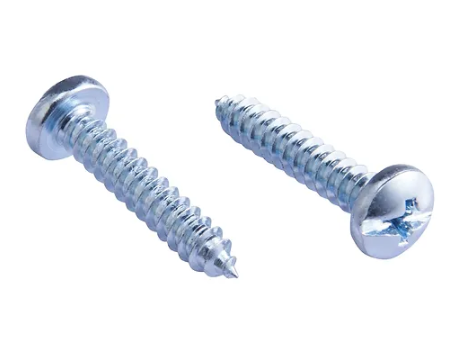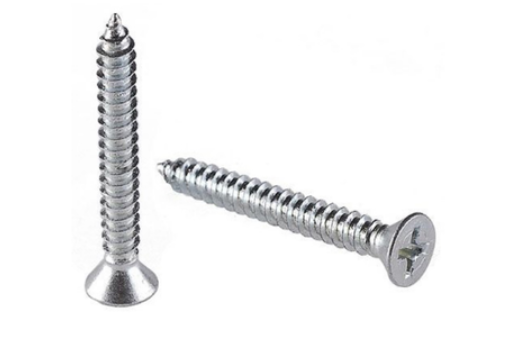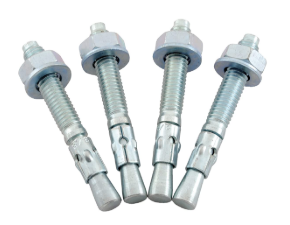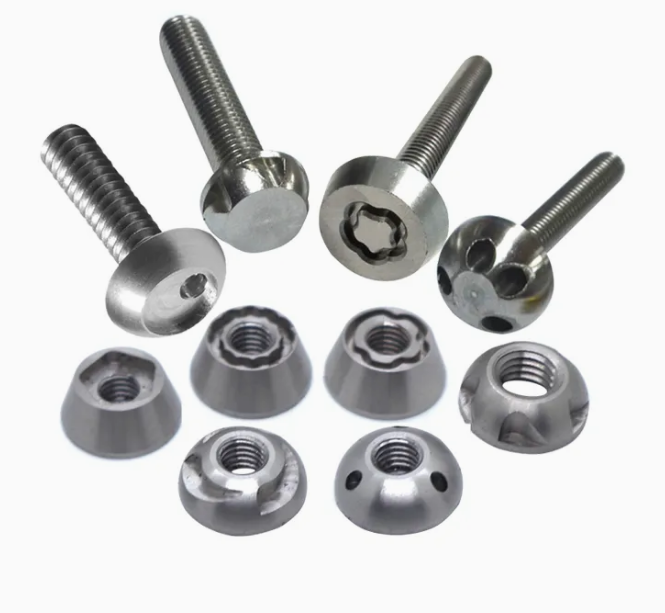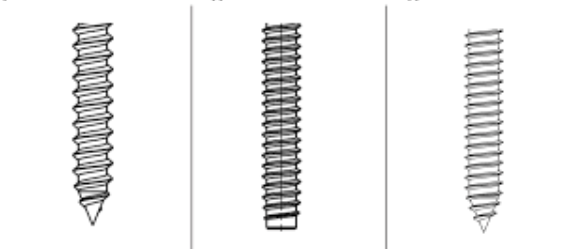For effective pocket hole joinery, one of the most neglected parts of the subject is perhaps the most important to successful joints – the screws that you use! In this Pocket Hole Srcew Guide, we’ll break down the sizes, length, types to give you tips for choosing the right screws for your next pocket hole project!
What are Pocket Hole Screws?
A pocket hole screw is a type of screw used in pocket hole joinery, which is a method of joining pieces of wood together. It is designed to create a strong and secure connection between two pieces of wood without the need for complicated joints or expensive tools. The pocket hole screw is a key component in this type of joinery, as it holds the pieces of wood together to create a durable and long-lasting joint.
Technically, you may be able to use any screw in a pocket hole. So why do most manufacturers of pocket hole cutters recommend specific screws? Because screws that are specifically designed for pocket hole joinery have certain features that can help you better align your work pieces avoid splits and increase the overall strength of your joint. And the following three key factors you should to know before choosing the screw for pocket holes!
1. Pocket Hole Screw Sizes
The first key point to consider is the size of the screw, and this is going to be dependent upon the thickness of the material that you’re going to be screwing your pocket hole screws into.
For example:
What is Pocket Hole Screw Size for 2×4?
For joining 2×4 lumber using pocket holes, the most commonly recommended pocket hole screw size is:
1 1/4 inch (1 1/4″) coarse thread pocket hole screws
This size screw works well for 2×4 dimensional lumber which actually measures 1.5 inches thick when new.
Some additional tips on pocket hole screw selection for 2x4s:
- Use coarse thread screws rather than fine thread for better holding power in the wood.
- Square head drive styles like square or star drive heads help prevent cam-out when driving the screws.
- Longer 2 1/2″ pocket hole screws can be used if joining 2x4s at right angles.
- For softwoods like pine, cedar, or fir, coarse 1 1/4″ pocket screws provide ample holding strength.
- For hardwoods, you may want to go up to 1 1/2″ pocket hole screws in 2x4s for better holding power.
What is Pocket Hole Screw Size for 3/4?
For 3/4″ thick wood stock, the recommended pocket hole screw size is:
1″ coarse thread pocket hole screws
Some more details:
- 3/4″ is a common thickness for shelving, cabinet sides, face frames, etc.
- 1″ pocket hole screws allow approximately 1/2″ of thread engagement into the 3/4″ thick material.
- Coarse threads provide better holding power compared to fine threads.
- Square or star drive heads help prevent cam-out when driving the screws.
You could potentially use 1 1/4″ pocket hole screws for 3/4″ stock as well, but 1″ is the minimum recommended size to ensure enough thread engagement.
If joining 3/4″ material at right angles, you may want to increase to 1 1/4″ or 1 1/2″ pocket screws for added strength across the joint.
For hardwoods, some recommend going up one screw size (1 1/4″) when joining 3/4″ stock for added holding power.
But in general, 1″ coarse thread pocket hole screws are the standard and safe choice for joining 3/4″ thick wood using pocket holes.
Pocket Hole Screw Size Chart (Metric)
Here’s a metric chart to help you choose the right screw size for your woodworking projects using pocket hole joinery. This chart assumes you are using one of the most common pocket hole jig systems:
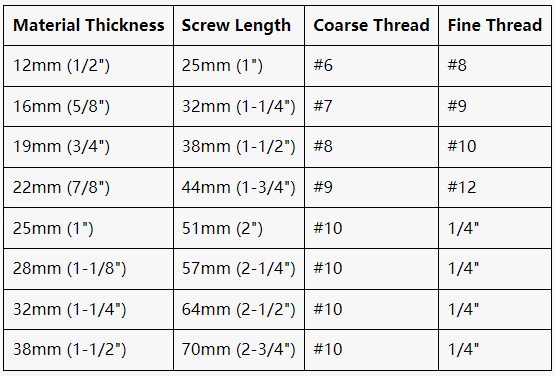
This chart shows the material thickness and the screw length that you want to consider if you’re going to be using pocket hole screws, so as an example if your material is one and one quarter inches thick you want to make sure that you use a two inch pocket hole screw third and most importantly there are several different techniques that you want to use when you’re using.Notes:
Notes:
The screw length should be approximately 1″ (25mm) longer than the material thickness for proper engagement.
For materials thicker than 38mm (1-1/2″), use a longer screw or consider alternative joinery methods.
Coarse-threaded screws are commonly used for softwood materials, while fine-threaded screws are suitable for hardwood and manufactured materials.
Fine-threaded screws are typically used for thicker materials or when more holding power is required.
Always follow the manufacturer’s recommendations for the specific project and materials used.
2. Pocket Hole Screw Length
Choosing the proper screw length for the job can be a little confusing as there are a lot of choices available. An inch and a quarter long screw is ideal for most woodworking that’s done with three quarter inch thick stock. If you work with a lot of half inch thick material you may require some shorter one inch screws on hand. And perhaps you’ll also want some longer inch and a half screws for when you work with thicker materials. Every pocket hole jig manufacturer has some sort of chart to tell you what length of screw you may need based upon the thickness of the material you’re using, but it’s still always a good idea to do an eyeball test just to be sure you have the right screw for the job. So we would like to break down the pocket hole screw length calculator further here.
How To Determine Pocket Hole Screw Length?
To determine the proper pocket hole screw length, you need to consider the thickness of the material you are joining. Here are the typical guidelines:
Measure the thickness of the material you are joining using a ruler or caliper.
Choose a screw length that is approximately 1 inch (25mm) longer than the thickness of the material. This ensures the screw has enough thread engagement in the second piece of wood for a strong joint.
For example:
- If joining 3/4 inch (19mm) thick material, use a 1-1/2 inch (38mm) screw.
- If joining 1 inch (25mm) thick material, use a 2 inch (51mm) screw.
- If joining materials of different thicknesses, base the screw length on the thicker piece of material.
For very thick material over 1-1/2 inches (38mm), you may need to use a longer screw or consider alternative joinery methods, as pocket holes have limitations.
Adjust the screw length if using hardwoods or manufactured materials, as they may require longer or shorter screws for proper holding power.
Pocket Hole Screw Length Chart
There’s a handy chart in the owners manual that will help you choose the right length screw:
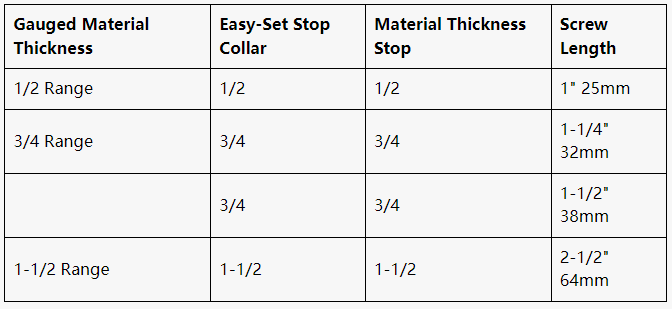
It’s really simple based on the thickness of your material and in general the thicker of the material the longer screw you’ll use to get the strongest joint.
3. Pocket Hole Screw Types
There are various types of pocket hole screws based on their heads, threads, drive, and other features:
- Pocket Hole Screw Heads
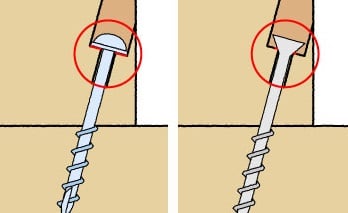
Washer Head: Features a large flat underside, providing a broad surface area against the workpiece. This head style is commonly used with materials like particleboard and melamine, where a wider surface area can distribute force more evenly and create a stronger joint. However, it does require a larger pocket.
Fillister (Cheese) Head: Has a compact shape which compresses wood fibers at the bottom of the pocket as it’s driven, preventing stripping. Suitable for materials that might otherwise strip with washer head screws. This head type is more appropriate for smaller pockets and provides a strong hold without needing as much space as the washer head.
- Pocket Hole Screw Threads
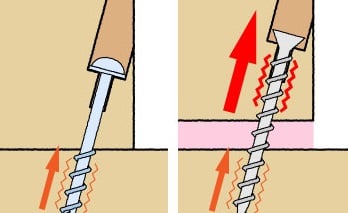
Coarse Threads: Ideal for softwood (e.g., pine, spruce). These threads are larger and provide a better grip in the softer fiber structure, enhancing the holding power without causing splitting.
Fine Threads: Best for hardwoods (e.g., oak, maple) that are denser. These threads are smaller, avoiding excessive displacement of material which could lead to splitting.
High-Low Threads: A combination of coarse and fine threads. They are versatile, suitable for both soft and hardwoods, and various manufactured materials, minimizing the risk of splitting while ensuring strong hold.
- Pocket Hole Screw Flutes
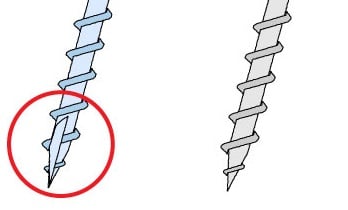
Self-Drilling Tips: Essential for pocket hole screws, these tips bore their own pilot holes, crucial since the pocket hole jig only prepares a pilot hole in one of the workpieces. This feature prevents splitting of the material when joining pieces.
- Pocket Hole Screw Drive Types
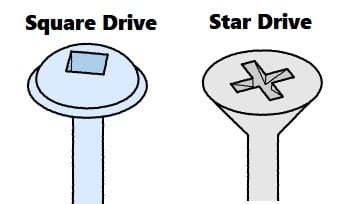
Torx (Star) Drive: Provides a good grip, reducing the likelihood of cam-out (where the screwdriver slips out of the screw head), especially beneficial when driving screws at an angle.
Square Drive: Offers a secure fit between the screw and the driver, maintaining alignment at various angles. This drive type is particularly useful for maintaining alignment in shallow-angled pockets.
Phillips Drive: Generally not recommended for pocket hole joinery due to the high risk of cam-out, especially when working at angles.
- Pocket Hole Screw Material Types
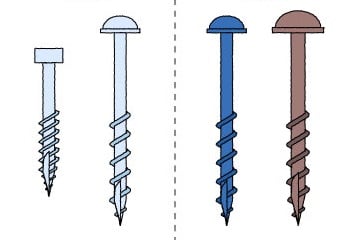
Zinc-Coated Screws: Suitable for indoor projects where moisture exposure is minimal. These screws are durable and provide adequate protection for most internal applications.
Blue-Kote Screws: Coated with a weather-resistant layer, making them ideal for projects that might face moisture but are not in constant contact with harsh elements.
Stainless Steel Screws: Best for extreme outdoor conditions, including maritime environments. They are also excellent for use with pressure-treated lumber or projects exposed to saltwater.
What Are the Best Pocket Hole Screw?
When choosing pocket hole screws, it’s crucial to consider the specific requirements of your project, including the type of material, joint strength required, environmental conditions, and the angles at which you’ll be working. Though it is hard to say which is the best screw for pocket holes in your project, we have the following recommendations for you:
Kreg Pocket Hole Screws: Kreg is a well-known brand in pocket hole joinery, and their screws are specifically designed for use with their pocket hole jigs. They offer a wide range of screw types, including zinc screws for indoor projects, Blue-Kote™ screws for damp or wet applications, and stainless steel screws for extreme environments exposed to moisture and corrosive elements.
Washer-Head Screws: These screws have a flat-bottomed, washer-like head that provides a wide bearing surface, preventing overdriving in softer materials like plywood and composites. They also distribute the load evenly across the joint, reducing the risk of splitting.
Self-Tapping Screws: Many pocket hole screws have a self-tapping notch at the tip, which helps to cut the threads as the screw is driven into the wood. This feature eliminates the need for predrilling and ensures a secure and tight joint.
It’s important to choose the right screw length and diameter for your project. The screw should be long enough to securely hold the joint together without protruding through the material. The diameter of the screw may also vary depending on the thickness of the material being joined. It’s worth pointing out that castle pocket hole cutting machines in particular allow you to adjust the distance between the pocket and to the end of the board, so you may use one screw length with a wide variety of material thicknesses this is a handy feature that i think is unique to that machine, it’s very useful.


